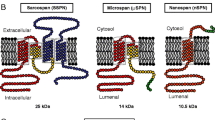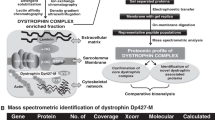Abstract
In this study, various members of the dystrophin family (dystrophin, the short dystrophin product Dp 71, utrophin and DRP2), and different members of the dystrophin-associated glycoprotein (DAG) complex (beta-dystroglycan, alpha-, beta-, gamma- and delta-sarcoglycans) were localized in bovine cardiac muscle using a battery of specific antibodies. We have established that dystrophin is exclusively associated with beta-dystroglycan and both alpha- and delta-sarcoglycans in cardiac muscle cell membranes. In contrast, utrophin is a specific component of intercalated disks together with beta- and gamma-sarcoglycans, while beta-dystroglycan, alpha- and delta-sarcoglycans are not present. Dp 71 is mainly localized at the T tubule transverse area. In dystrophin deficient cardiac muscle, utrophin and beta-sarcoglycan were observed in intercalated disks and at the sarcolemma of each cardiocyte. Our results revealed that complexes of associated glycoproteins differ in cardiac muscle when associated with dystrophin or utrophin. Despite the described sequence homologies between dystrophin and utrophin, the present results indicate that these proteins have different roles in some specific cardiac cell areas.
Similar content being viewed by others
References
Carlson CG (1998) The dystrophinopathies: An alternative to the structural hypothesis. Neurobiology of Disease 5: 3–15.
Cox GF and Kunkel LM (1997) Dystrophies and heart disease. Current Opinion in Cardiol 12: 329–343.
Deys KA, Bowe BA, Leszyk JD and Fallon JR (1995) The alpha dystroglycan/beta dystroglycan complex-Membrane organization and relationship to an agrin receptor. J Biol Chem 270: 25956–25959.
Dixon AK, Tait TM, Campbell EA, Bobrow M, Roberts RG and Freeman TC (1997) Expression of the dystrophin-related protein 2 (DRP2) transcript in the mouse. J Mol Biol 270: 551–558.
Ervasti JM and Campbell KP (1993) Dystrophin and the membrane skeleton. Curr Opin Cell Biol 5: 82–87.
Fabbrizio E, Bonet-Kerrache A, Leger JJ and Mornet D (1993) Actin-dystrophin interface. Biochemistry 32: 10457–10463.
Fabbrizio E, Nudel U, Hugon G, Robert A, Pons F and Mornet D (1994) Characterization and localization of a 77 kDa protein related to the dystrophin gene family. Biochem J 299: 359–365.
Gee SH, Montanaro F, Lindenbaum MH and Carbonetto S (1994) dystroglycan-alpha, a dystrophin-associated glycoprotein, is a functional agrin receptor. Cell 77: 675–686.
Henry MD and Campbell KP (1996) Dystroglycan: an extracellular matrix receptor linked to the cytoskeleton. Curr Opin Cell Biol 8: 625–631.
Ibraghimov-Beskrovnaya O, Ervasti JM, Leveille CJ, Slaughter CA, Sernett SW and Campbell KP (1992) Primary structure of dystrophin-associated glycoproteins linking dystrophin to the extracellular matrix. Nature 355: 696–702.
Klietsch R, Ervasti JM, Arnold W, Campbell KP and Jorgensen A (1993) Dystrophin-glycoprotein complex and laminin colocalize to the sarcolemma and transverse tubules in human cardiac muscle. Circ Res 72: 349–360.
Koenig M, Hoffman EP, Bertelson CJ, Monaco AP, Feener C and Kunkel LM (1987) Complete cloning of the Duchenne muscular dystrophy (DMD) cDNA and preliminary genomic organization of the DMD gene in normal and affected individuals. Cell 50: 509–517.
Madhavan R and Jarrett H (1995) Interaction between dystrophin glycoprotein complex proteins. Biochemistry 34: 12204–12209.
Margossian SS and Lowey S (1973) Substructure of the myosin molecule. J Mol Biol 74: 313–330.
Meng H, Leddy JJ, Frank J, Holland P and Tuana BS (1996) The association of cardiac dystrophin with myo®brils/Z-disk regions in cardiac muscle suggests a novel role in the contractile apparatus. J Biol Chem 271: 12364–12371.
Nigro V, Piluso G, Belsito A, Politano L, Puca AA, Papparella S, Rossi E, Viglietto G, Esposito MG, Abbondanza C, Medici N, Molinari AM, Nigro G and Puca GA (1996) Identification of a novel sarcoglycan gene at 5q33 encoding a sarcolemmal 35 kDa glycoprotein. Hum Molec Genet 5: 1179–1186.
Ozawa E, Noguchi S, Mizumo Y, Agiwara Y and Yoshida M (1998) From dystrophinopathy to sarcoglycanopathy: evolution of a concept of muscular dystrophy. Muscle and Nerve 21: 421–438.
Pasternak C, Wong S and Elson EL (1995) Mechanical function of dystrophin in muscle cells. J Cell Biol 128: 355–361.
Peri V, Ajdukovic B, Holland P and Tuana BS (1994) Dystrophin predominantly localizes to the transverse tubule/Z-line regions of single ventricular myocytes and exhibits distinct associations with the membrane. Mol Cell Biochem 130: 57–65.
Pons F, Augier N, Leger J, Robert A, Tome FMS, Fardeau M, Voit T, Nicholson LVB, Mornet D and Leger JJ (1991) A homologue of dystrophin is expressed at the neuromuscular junctions of normal individuals and DMD patients, and of normal and mdx mice. FEBS Letters 282: 161–165.
Pons F, Nicholson LVB, Robert A, Voit T and Leger JJ (1993) Dystrophin and dystrophin-related protein (utrophin) distribution in normal and dystrophin-deficient skeletal muscle. Neuromusc Disord 3: 507–517.
Pons F, Robert A, Fabbrizio E, Hugon G, Califano JPC, Fehrentz JA, Martinez J and Mornet D (1994) Utrophin localization in normal and dystrophin-deficient heart. Circulation 90: 369–374.
Rivier F, Robert A, Hugon G and Mornet D (1997) Different utrophin and dystrophin properties related to their vascular smooth muscle distributions. FEBS Lett 408: 94–98.
Roberts RG, Freeman TC, Kendall E, Vetrie DLP, Dixon AK, Shaw-Smith C, Bone Q and Bobrow M(1996) Characterization of DRP2, a novel human dystrophin homologue. Nature Genet 13: 223–226.
Stevenson S, Rothery S, Cullen MJ and Severs NJ (1997) Dystrophin is not a specific component of the cardiac costamere. Circ Res 80: 269–280.
Stevenson S, Rothery S, Cullen MJ and Severs NJ (1998) Spatial relationship of the C-terminal domains of dystrophin and beta-dystroglycan in cardiac muscle support a direct molecular inter-action at the plasma membrane. Circ Res 82: 82–93.
Straub V, Bittner RE, Leger JJ and Voit T (1992) Direct visualization of the dystrophin network on skeletal muscle fiber membrane. J Cell Biol 119: 1183–1191.
Tinsley JM, Blake DJ, Roche A, Fairbrother U, Riss J, Byth BC, Knight AE, Kendrick-Jones J, Suther GK, Love DR, Edwards YH and Davies KE (1992) Primary structure of dystrophin related protein. Nature 360: 591–593.
Towbin JA (1998) The role of cytoskeletal proteins in cardiomyopat-hies. Current Opinion in Cell Biology 10: 131–139.
Winder SJ (1997) The membrane-cytoskeleton interface; the role of dystrophin and utrophin. J Muscle Res Cell Motil 18: 617–629.
Yarom R, Morris GE, Froede R and Schaper J (1992) Myocardial dystrophin immunolocalization at sarcolemma and transverse tubule. 4Experientia 48: 614–616.
Author information
Authors and Affiliations
Rights and permissions
About this article
Cite this article
Rivier, F., Robert, A., Royuela, M. et al. Utrophin and dystrophin-associated glycoproteins in normal and dystrophin deficient cardiac muscle. J Muscle Res Cell Motil 20, 305–314 (1999). https://doi.org/10.1023/A:1005426920070
Issue Date:
DOI: https://doi.org/10.1023/A:1005426920070




